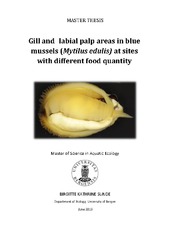| dc.contributor.author | Sunde, Birgitte Kathrine | eng |
| dc.date.accessioned | 2013-07-10T12:23:03Z | |
| dc.date.available | 2013-07-10T12:23:03Z | |
| dc.date.issued | 2013-06-01 | eng |
| dc.date.submitted | 2013-06-01 | eng |
| dc.identifier.uri | http://hdl.handle.net/1956/6789 | |
| dc.description.abstract | Suspension feeding bivalves captures and process particles with their gills and labial palps. These foraging apparatus are known to be flexible in size related to seston quantity and quality. It is important to understand morphological and physiological adaptations in bivalves to understand the mechanisms of the feeding processes. Gill and labial palp areas were measured in the blue mussel, Mytilus edulis, from two sites in Lysefjorden (Norway), one upwelling site that was under influence of forced upwelling to enhance chlorophyll a concentrations and one control station outside the influenced area of upwelling. Measurements of gill and labial palp areas were conducted in March, June and October 2011. Annual mean concentrations of estimated chlorophyll a were significantly different between the two sites and were 1.38 mg/m3 and 1.60 mg/m3 at the control and upwelling site respectively. The annual suspended particulate matter (SPM) was 2.5 g/m3 (control) and 3.3 g/m3 (upwelling), and was not significantly different between sites. Gill and labial palp areas (mm2) were closely and positively related to shell length (mm) and dry flesh weight (g), but there were no clear difference in these areas between the sites. There was a significant difference in gill-to-palp (GA: PA) ratio between the two sites in October, where GA: PA increased with shell length at the upwelling site, and decreased at the control site. Changes in GA: PA ratio was probably related to labial palp area variations which may have been influenced by the significant difference in chlorophyll a concentration during the year. Further it was found that measures of gill areas was significantly higher for frozen opposed to live tissue, and mussels sampled in March and June (frozen) could not be compared to mussels sampled in October (live). The measuring of gill area was more accurate compared to labial palp area, but both areas were measured with a standard deviation less than 10 % the reference value. A regression of gill area (GA) against dry flesh weight (W) in the form GA=a Wb provided smaller b-value at the control site compared to other studies, while the a-value was more similar. The results indicate differences in GA: PA ratio within the same fjord at small differences in chlorophyll a, while differences in gill and labial palp area probably need larger differences in seston concentration to see significant difference similar to what have been found in other studies. | en_US |
| dc.format.extent | 2728867 bytes | eng |
| dc.format.mimetype | application/pdf | eng |
| dc.language.iso | eng | eng |
| dc.publisher | The University of Bergen | en_US |
| dc.subject | blue mussels | eng |
| dc.subject | blåskjell | eng |
| dc.subject | gills | eng |
| dc.subject | labial palps | eng |
| dc.subject | blåskjell | nob |
| dc.subject | gjeller | nob |
| dc.subject | mattilgang | nob |
| dc.title | Gill and labial palp areas in blue mussels (Mytilus edulis) at sites with different food quantity | en_US |
| dc.type | Master thesis | |
| dc.rights.holder | Copyright the author. All rights reserved | en_US |
| dc.description.localcode | MAMN-MAR | |
| dc.description.localcode | MAR399 | |
| dc.subject.realfagstermer | http://data.ub.uio.no/realfagstermer/c012588 | |
| dc.subject.realfagstermer | http://data.ub.uio.no/realfagstermer/c012740 | |
| dc.subject.realfagstermer | http://data.ub.uio.no/realfagstermer/c004682 | |
| dc.subject.nus | 751599 | eng |
| fs.subjectcode | MAR399 | |
